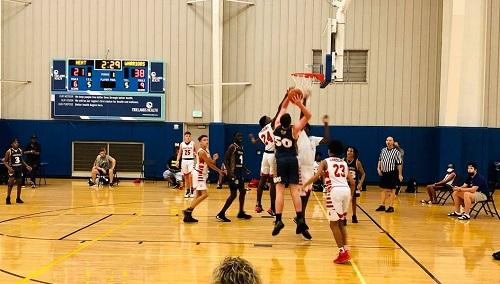

The numbers added up. Three back-to-back youth tournaments. 80 teams each. Plenty of precautions. Even more dedication on the part of an incredibly hardworking venue staff, event owner and destination. And one big success story.
The news has been nothing but positive coming out of the National Travel Basketball Association’s three national championship events (two for boys, one for girls, all ranging in age from third to twelfth grade) that took place at the Myrtle Beach Sport Center in July. And according to John Whitley, NTBA’s president, it was wire-to-wire communication, smart practices and cooperation between all parties involved that generated the big win.
How big? Over $2 million in economic impact.
“We wanted to make sure everyone left feeling great about the event,” Whitley notes. “And so even before we started accepting entries, we were asking ourselves how we could do this, how we could keep safety as the number-one priority and still make sure people had a good time.”
Planning started with dissecting local regulations, and examining CDC guidelines, in order to determine the correct number of people who could participate. And it started in advance – before, in fact, the tournament was even publicized.

“There wasn’t really an exact formula to use,” Whitley says, “so we based it, for us, on the fact that Myrtle Beach Sports Center has eight courts. We knew we didn’t want to be using all eight courts at once – it might have been that the state would allow it, and that the CDC would be okay with it but we thought maybe the parents wouldn’t feel safe.”
Ultimately, NTBA and MBSC decided to use a total of five courts. Creating a healthful atmosphere also depended upon setting the correct number of teams. Typically, the three tournaments together draw over 700 teams from 23 states.
“This year, we had about 30 percent capacity,” says Whitley. “We only allowed about 200 teams altogether. It was very important for us to know from a health and safety standpoint what we could do, and how we could run the tournament safely.”
Rather than having team members sit together on benches, individual chairs were placed on the sidelines, and were spaced apart. Unless they were warming up or playing, athletes were asked to wear masks, and to use individual water bottles (rather than a communal water fountain). The tournament provided Gatorade to all players in individual bottles as well.
“You take all the precautions you can,” said Whitley. “Everything we could think of, we did.”
Spectators, too (and they were present) were also required to adhere to regulations concerning wearing masks and sitting apart (with the exception of family members).
“We did allow spectators, but we used a formula; for every 1,000 square feet in the facility, we had five people. That meant that at any given time, there was a maximum number of 500 inside. The Myrtle Beach Sports Center actually has 4,679 seats; it’s a 100,000-square-foot facility.”
After each wave of games took place, the arena was emptied of spectators, officials and athletes. Sanitization then took place; the area was fogged and all surfaces that had been touched were wiped down.
“We would have 30 minutes once the building emptied out and our team would go to work, sanitizing everything,” notes Lyon.
The Myrtle Beach Sports Center also took great precautions to keep hand sanitizer available. While restrooms and concession stands were open (with proper social distancing and safety measures in place), locker rooms were not, in order to avoid crowding.

And, says Whitley, it all worked, thanks to good communication and well-posted signage throughout the facility.
“We told the coaches ahead of time everything that we were doing, so that there were no gray areas.”
The end result was “positive feedback and so many coaches saying, “Thank you – we felt so safe here, and you did exactly what you said you were going to do.”
The tournaments were recorded and livestreamed on BallerTV, something else that generated positive reviews.
“We got a lot of compliments on that – especially grandparents who couldn’t come but wanted to be able to see the games. I think, certainly, that streaming is going to be the wave of the future. It’s very important for event operators to do.”
The end result was a tournament that generated uniformly positive reviews.
“Overall, what we found was that kids had been cooped up and they were just dying to get out there and do something fun. The coaches said they’d been begging to get out and play, and to do that in a safe manner. We were able to give them an outlet they didn’t have when they were in quarantine.”

Players, coaches and parents were in unanimous positive approval – something likely to generate plenty of return business next year. And, says Whitley, it would not have been possible without the start-to-finish cooperation, communication and dedication he encountered in Myrtle Beach.
“It required a LOT of extra work but it was absolutely worth it. We worked hand-in-hand with Myrtle Beach Sports Center directly and with the city as well. They were all absolutely wonderful to work with. I think that without them, and without the city to work with so closely, this never could have happened.”
Since the time of the tournament, Lyon notes, regulations have tightened, and now, events are required to tell the state in advance if they intend to be filling more than 50 percent of the venue.
The Myrtle Beach Sports Center, which celebrates its fifth anniversary this year, has been partnering with NTBA throughout. And, says Lyon, it was a great feeling to welcome the kids back.
“That was the biggest thing – they were all so happy to be back. And it was great to be able to let everyone play again because that’s what kids want to do – play the sport they love. We’re so happy to have them and we loved hosting them.”

